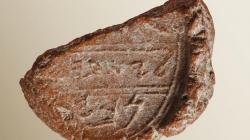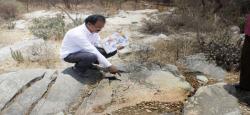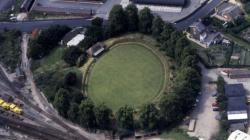INSTITUT SUPERIEUR D'ANTHROPOLOGIE
INSTITUTE OF ANTHROPOLOGY
ONLINE COURSES / COURS A DISTANCE
SPRING TERM : APRIL 2018
REGISTER NOW
EGYPTE –  Tuna el-Gebel - Egypt's Antiquities Ministry announced on Saturday the discovery of an ancient necropolis near the Nile Valley city of Minya, south of Cairo, the latest discovery in an area known to house ancient catacombs from the Pharaonic Late Period and the Ptolemaic dynasty. The large cemetery is located north of Tuna al-Gabal area, a vast archaeological site on the edge of the western desert. It hosts a range of family tombs and graves. "We will need at least five years to work on the necropolis," Antiquities Minister Khaled al-Anani said, "This is only the beginning of a new discovery." Archaeologists started excavation work in the area started late last year on a quest to find the remainder of the cemetery of Upper Egypt's 15th nome during ancient times. They found tombs belonging to priests of Thoth, the ancient god of the moon and wisdom. One tomb includes more than 1,000 statues and four well preserved alabaster canopic jars inscribed with hieroglyphics and designed to hold the mummified internal organs of their owner who was a high priest of the god Thoth. The priest's mummy was also found decorated with blue and red beads and bronze gilded sheets. Archaeologists also uncovered 40 sarcophagi believed to belong to the priest's family members, some bearing the names of their owners in hieroglyphics. Another tomb includes several coffins, statues depicting ancient priests and other funerary artifacts. Mostafa Waziri, head of the archaeological mission, says eight tombs have been uncovered so far and he expects more will be discovered soon. In 2017, the ministry found a necropolis holding at least 17 mummies in the area of Tuna al-Gabal. The area is also known to include tombs, a funerary building and a large necropolis for thousands of mummified ibis and baboon birds, as well as other animals.
Tuna el-Gebel - Egypt's Antiquities Ministry announced on Saturday the discovery of an ancient necropolis near the Nile Valley city of Minya, south of Cairo, the latest discovery in an area known to house ancient catacombs from the Pharaonic Late Period and the Ptolemaic dynasty. The large cemetery is located north of Tuna al-Gabal area, a vast archaeological site on the edge of the western desert. It hosts a range of family tombs and graves. "We will need at least five years to work on the necropolis," Antiquities Minister Khaled al-Anani said, "This is only the beginning of a new discovery." Archaeologists started excavation work in the area started late last year on a quest to find the remainder of the cemetery of Upper Egypt's 15th nome during ancient times. They found tombs belonging to priests of Thoth, the ancient god of the moon and wisdom. One tomb includes more than 1,000 statues and four well preserved alabaster canopic jars inscribed with hieroglyphics and designed to hold the mummified internal organs of their owner who was a high priest of the god Thoth. The priest's mummy was also found decorated with blue and red beads and bronze gilded sheets. Archaeologists also uncovered 40 sarcophagi believed to belong to the priest's family members, some bearing the names of their owners in hieroglyphics. Another tomb includes several coffins, statues depicting ancient priests and other funerary artifacts. Mostafa Waziri, head of the archaeological mission, says eight tombs have been uncovered so far and he expects more will be discovered soon. In 2017, the ministry found a necropolis holding at least 17 mummies in the area of Tuna al-Gabal. The area is also known to include tombs, a funerary building and a large necropolis for thousands of mummified ibis and baboon birds, as well as other animals.
http://abcnews.go.com/International/wireStory/archaeologists-find-ancient-necropolis-egypt-53329145
NOUVELLE ZELANDE – Wairau Bar - What's thought to have been one of the landing sites of New Zealand's first settlers, about 800 years ago, has since been hit by at least four major earthquakes and three tsunamis. The Wairau Bar, a windswept wedge of grass and gravel off the Marlborough coastline, has been one of New Zealand's most important archaeological sites since relics uncovered there were found to have come from what were likely our first human inhabitants. Successive studies have put their arrival at the bar, which at that point would have been a scrub-covered island, at some point between 1288 and 1300. Now, two Victoria University archaeologists have uncovered evidence of earthquakes and tsunamis at the site over past centuries - some which may have killed some of the people once living there.
https://www.odt.co.nz/news/national/evidence-multiple-quakes-tsunami-ancient-nz-settlement
ISRAEL –  Jerusalem - A team of Israeli archaeologists have discovered a 2,700-year-old clay seal that may bear the name stamp of the biblical prophet Isaiah. "We found the eighth-century B.C.E. seal mark that may have been made by the prophet Isaiah himself only 10 feet away from where we earlier discovered the highly-publicized bulla of King Hezekiah of Judah," said Dr. Eilat Mazar of the Hebrew University in Jerusalem. The discovery was made as part of the Ophel Excavations at the foot of the southern wall of the Temple Mount in Jerusalem. The clay seal was found "right outside the royal bakery in undisturbed Iron Age remains," the statement says. But due to damage to the inscription, it isn't possible to positively identify the seal. The bulla is marked with the Hebrew name of Isaiah, followed by "nvy." But in order for "nvy" to spell out "prophet," it would need to end with the Hebrew letter aleph, but the damage makes that unclear. "The absence of this final letter... requires that we leave open the possibility that it could just be the name Navi." Mazar said. "The name of Isaiah, however, is clear." Mazar's article about the seal is in the March/April/May/June double issue of Biblical Archaeology Review.
Jerusalem - A team of Israeli archaeologists have discovered a 2,700-year-old clay seal that may bear the name stamp of the biblical prophet Isaiah. "We found the eighth-century B.C.E. seal mark that may have been made by the prophet Isaiah himself only 10 feet away from where we earlier discovered the highly-publicized bulla of King Hezekiah of Judah," said Dr. Eilat Mazar of the Hebrew University in Jerusalem. The discovery was made as part of the Ophel Excavations at the foot of the southern wall of the Temple Mount in Jerusalem. The clay seal was found "right outside the royal bakery in undisturbed Iron Age remains," the statement says. But due to damage to the inscription, it isn't possible to positively identify the seal. The bulla is marked with the Hebrew name of Isaiah, followed by "nvy." But in order for "nvy" to spell out "prophet," it would need to end with the Hebrew letter aleph, but the damage makes that unclear. "The absence of this final letter... requires that we leave open the possibility that it could just be the name Navi." Mazar said. "The name of Isaiah, however, is clear." Mazar's article about the seal is in the March/April/May/June double issue of Biblical Archaeology Review.
https://www.cnet.com/news/prophet-isaiah-signature-may-have-been-found-on-clay-seal/
INDE –  Srinivasapuram - An eighth century CE linear drawing chiselled on a piece of rock, along with an old inscription, was found at Srinivasapuram village near Piduguralla in Guntur district, said Cultural Centre of Vijayawada and Amaravati (CCVA) CEO Dr E Sivanagi Reddy. Dr Reddy said here on Saturday that under ‘Preserve Heritage for Posterity’ launched by CCVA, they explored Palnadu area and discovered the fish on rock related to Jalapeswara temple of the village, located eight km away from Piduguralla town. He said the fish on a rock was measuring 90 cm X 10 cm and might have been chiselled during the Eastern Chalukyan era by two sculptors viz., Maindarama and Chamoju. Dr Reddy said the village Srinivasapuram was located on the right bank of the River Krishna. He recalled that Chalukyas could have named God after the river water (Jala) as Jalapeswara and the village Jalapeswarapura. The team of archaeologists also noticed the ruins of two temples nearby, he said and pointed out that they need immediate attention from the department of archaeology for the preservation. Dr Reddy also observed limestone pillars of local Buddhist Vihara dated back to third century CE (Ikshwaku period) were found at the site. He said temple once up on a time could have Buddhist site.
Srinivasapuram - An eighth century CE linear drawing chiselled on a piece of rock, along with an old inscription, was found at Srinivasapuram village near Piduguralla in Guntur district, said Cultural Centre of Vijayawada and Amaravati (CCVA) CEO Dr E Sivanagi Reddy. Dr Reddy said here on Saturday that under ‘Preserve Heritage for Posterity’ launched by CCVA, they explored Palnadu area and discovered the fish on rock related to Jalapeswara temple of the village, located eight km away from Piduguralla town. He said the fish on a rock was measuring 90 cm X 10 cm and might have been chiselled during the Eastern Chalukyan era by two sculptors viz., Maindarama and Chamoju. Dr Reddy said the village Srinivasapuram was located on the right bank of the River Krishna. He recalled that Chalukyas could have named God after the river water (Jala) as Jalapeswara and the village Jalapeswarapura. The team of archaeologists also noticed the ruins of two temples nearby, he said and pointed out that they need immediate attention from the department of archaeology for the preservation. Dr Reddy also observed limestone pillars of local Buddhist Vihara dated back to third century CE (Ikshwaku period) were found at the site. He said temple once up on a time could have Buddhist site.
http://www.thehansindia.com/posts/index/Andhra-Pradesh/2018-02-25/8th-century-linear-drawing-of-fish-found-/361439
NEPAL - Kapilvastu - The latest archaeological excavation carried out under the aegis of Department of Archaeology has discovered that Kapilvastu has the highest number of archaeological sites in the country. It has identified 136 archaeological sites in the district. Lumbini, a UNESCO World Heritage site and the birthplace of Gautam Buddha, lies in Province 5 Rupandehi has 99 archaeologically important sites while Nawalparasi has around 40 such places, said Kunwar. Some of the major archaeological sites in the Kapilvastu district include Tilaurakot, Aaraurakot, Kudan, Niglihawa, Sagarhawa, Gotihawa, Dohani, Prachin Stupa, Sisahaniya among others. The ruins of King Suddhodan’s palace is now a protected zone. Suddhodan was Buddha’’s father and ruled the ancient kingdom Tilaurakot. The department has also acquired land plots around the area where it plans to carry out archaeological research. During the excavationin Tilaurakot, earthenware, statues, silver coins and some metal artefacts were discovered. Laboratory test of these artefacts have revealed that human civilisation existed in this area even before 800 BC.
https://thehimalayantimes.com/nepal/136-archaeological-sites-found/
INDE - Bargarh - Pre-historic era stone tools, artefacts and weapons have been Bargarh district unearthed during archaeological excavations by Sambalpur University in , a faculty of the university said. P K Behera, associate professor of history, who is leading the ongoing explorations and excavations by involving post graduate students and research scholars since 2015, said the tools would be at least 2 lakh years old. "These would tell us about human migration to this part of the world and their habitation," Behera told TOI. "Stone tools manufactured by these early people show their potential skill in using different types of contemporary technology and have striking similarities with those reported from several places of eastern and southern Africa, besides western Europe which have been proved to be pre-historic," he said. he exploration site is located in the upper stream of Danta, a tributary of Jira river, which falls into the Mahanadi near Torajunga village in Bargarh district. "Most of these tools seem to have been designed for hunting large-sized game animals, now abundantly available in the Debrigarh wildlife sanctuary, located a few km s north of the site," he said. Behera said soil samples from different levels will be sent to different geophysical laboratories of the country to find out the exact date of the early human movement in the area of investigation using palaeomagnetic and optically-stimulated luminescence.
https://timesofindia.indiatimes.com/city/bhubaneswar/2-lakh-year-old-stone-tools-found-in-bargarh-district/articleshow/63052928.cms
ROYAUME UNI –  Welshpool - Archaeologists have resumed a dig at Welshpool's medieval castle. Previous excavations found that parts of the building were well preserved. "This year we are exploring the ditch around the castle mound," said CPAT community archaeologist Alex Sperr.
Welshpool - Archaeologists have resumed a dig at Welshpool's medieval castle. Previous excavations found that parts of the building were well preserved. "This year we are exploring the ditch around the castle mound," said CPAT community archaeologist Alex Sperr.
http://www.bbc.co.uk/news/uk-wales-mid-wales-43140366